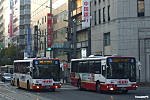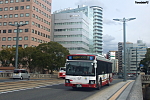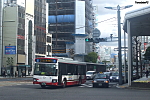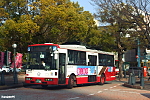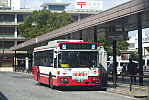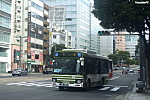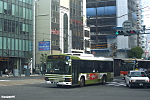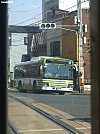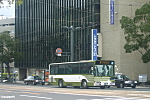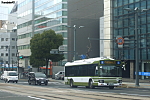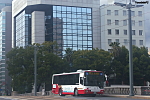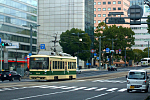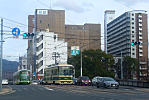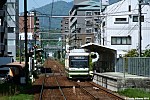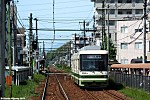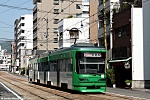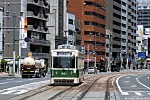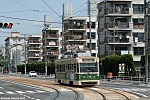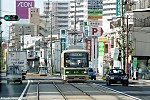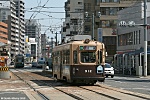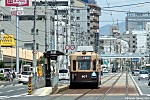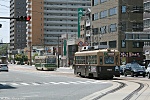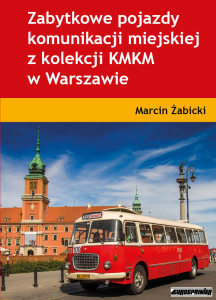Jesteś niezalogowany | Zaloguj się | Zarejestruj się

Szukaj zdjęcia
Mitsubishi Fuso PKG-MP35UM Aero Star #515
13 lutego 2019 - Hiroshima, Naka-ku, Hatchōbori (広島県広島市中区八丁堀).23-1: 横河駅 (Yokogawa-eki) → 大学病院 (Daigaku-byōin)
To the right, 536 on rte 24: 吉島営業所 (Yoshijima Eigyōsho) → 広島駅 (Hiroshima-eki)
Most of the routes operated by this company run every 12 minutes in the PM peak and every 15 in the interpeak (with AM peak services so often that a timetable isn`t really needed), although with individual routings being split off as variations some sections have poorer levels of service - for example on rte 23 every other trip is done as rte 23-1 as seen here, leaving behind a frequency of every 24 to 30 minutes on the unique sections. Terminus departures take place betweem 6am and 10pm, so as per the norm in Japan good luck with late evening services. Also as per the norm in Japan, and the same takes place on Hiroden`s network, the fare is paid when alighting at the front door, with a ticket to be taken when boarding by the middle door if paying by cash. I`m not exactly sure if this was brought in after my stay there, but there is a designated zone in Hiroshima city centre where all trips are 190 yen (€1.45) regardless of distance - outside of this zone, fares are calculated depending on the distance travelled, with adult singles ranging from 170 to 520 yen (€1.30 to €4) each.


Autor: TranslatorPS 

Miejsce: 広島市 [Hiroshima-shi] (Hiroshima-ken)
| Właściciel: Hiroshima Bus 広島市 [Hiroshima-shi] | Linia: 23-1
Isuzu QDG-LV290N1 Erga Non-Step #240
14 lutego 2019 - Hiroshima, Inari-ōhashi (広島県広島市稲荷大橋).25: 広島駅 (Hiroshima-eki) → 井口車庫 (Inokuchi-shako)
If I am to believe Japanese Wikipedia, a portion of this company`s fleet is made up of used buses bought from the capital region. While the Erga in the photo is not one of those - having been bought brand new - it`s still curious as to why the Hiroshima-based company wasn`t seeking its fleet somewhere closer, for example in the Keihanshin area. On the other hand I`m under the impression that fleet replacement is going somewhat faster in the capital region, even if there isn`t really a push in Japan to operate low-floor only services.
Speaking of low-floor services, rte 25 is the only route of this company where departures scheduled to be operated by low-floor buses are marked. This is also particularly rare in Japan.


Autor: TranslatorPS 

Miejsce: 広島市 [Hiroshima-shi] (Hiroshima-ken)
| Właściciel: Hiroshima Bus 広島市 [Hiroshima-shi] | Linia: 25
Isuzu QDG-LV290N1 Erga Non-Step #195
14 lutego 2019 - Hiroshima, Naka-ku, Ebisuchō (広島県広島市中区恵美須町).21-2: 広島駅 (Hiroshima-eki) → 広島港 (Hiroshima-minato)
To go along with the other photo, the typical version of rte 21 on its eastern half. The 八丁堀 Hatchōbori sheet doesn`t indicate a variation - all 21 trips go through this junction after all - but it`s more likely to serve to highlight that this route serves this major transfer point to begin with.


Autor: TranslatorPS 

Miejsce: 広島市 [Hiroshima-shi] (Hiroshima-ken)
| Właściciel: Hiroshima Bus 広島市 [Hiroshima-shi] | Linia: 21-2
Nissan Diesel KC-UA460LSN / FHI 7E #391
13 lutego 2019 - Hiroshima, Nishi-ku, Yokogawachō 3-chōme (広島県広島市西区横川町3丁目), Yokogawa-eki bus terminus. The second company that I have something worth mentioning about when it comes to Hiroshima is this, Hiroshima Bus. Most of their network serves central Hiroshima, operating on routes numbered from 21 to 30 in a manner not conflicting with Hiroden`s network. They also share a number of circular routes near the business district and Hiroshima station with the tram operator. Their 224 city buses and 20 coaches are spread out between eight garages, operating a network of 212 km in length.

Autor: TranslatorPS 

Miejsce: 広島市 [Hiroshima-shi] (Hiroshima-ken)
| Właściciel: Hiroshima Bus 広島市 [Hiroshima-shi]
Nissan Diesel ADG-RA273KAN / NSK 96MC #627
13 lutego 2019 - Hiroshima, Minami-ku, Matsubarachō (広島県広島市南区松原町), Hiroshima-eki bus terminal.21-1: 広島駅 (Hiroshima-eki) → 広島港 (Hiroshima-minato)
Hiroshima station is an important point in this company`s network, as most of their routes meet here. Rte 21-1 seen in the photo is part of a really strange corridor, which in reality contains three separate routes: 21 which runs from neighbourhoods in eastern Hiroshima to the city centre, 21-2 which runs from Hiroshima station to Hiroshima port, and 21-1 as in the photo, which runs a route similar to 21-2, but along different streets (it`s pretty much a carbon copy of tram rte 1, aside from running two streets away towards the end of the route). Trips operating from one extreme end to the other only operate during rush hours, and not that many of them either - during most of the day this operates as realistically two routes with just four (!) stops in common. Of course on the common section this is all printed on one timetable page, which is of course loaded with variation markers - and while each half runs in the interpeak every 15 and is aligned to run every 7-8 minutes on the common section going westbound, they`re scheduled bumper to bumper going eastbound...


Autor: TranslatorPS 

Miejsce: 広島市 [Hiroshima-shi] (Hiroshima-ken)
| Właściciel: Hiroshima Bus 広島市 [Hiroshima-shi] | Linia: 21-1
Hino SKG-KR290J2 Rainbow II #50544
14 lutego 2019 - Hiroshima, Naka-ku, Ebisuchō (広島県広島市中区恵美須町).4: 仁保車庫前 (Niho-shako-mae) → 県庁前 (Kenchō-mae)
This photo should make for a great example of the inconsistent marking of variations. There is a reason why I described the example of rte 4 as "good enough" under the last photo, and not completely good. The placard with "仁保南" (Niho-minami) seen on the driver`s console, alongside the top row of the LED scroll most likely, indicates a variation via the neighbourhood going by that name instead of taking a simplier route down the major roads. Travelling out of the city centre this variation is denoted as 4-2, as opposed to 4-1, but going inbound where there are only four stops in common before the route splits Hiroden isn`t messing around with a variation marker anymore. To make things even better, the route marked as a variation is done by about 60% of the departures from Niho garage.


Autor: TranslatorPS 

Hino QKG-KV234N3 Blue Ribbon II #74834
14 lutego 2019 - Hiroshima, Naka-ku, Ebisuchō (広島県広島市中区恵美須町).2-2: 府中山田 (Fuchū-yamada) → 県庁前 (Kenchō-mae)
Hiroden uses a very peculiar route numbering system, which may be familiar to bus users in certain parts of the UK, or even better, Northern Ireland. Needless to say, bus and tram route numbers overlap, but that is no surprise to me. Most bus routes function as tree-like networks with a common route number - they depart from Hiroshima city centre along common routes that form the trunk of the tree, but sooner or later variations start splitting off like branches. To reduce the number of possible mistakes by passengers, individual variations are marked with an extra number after a hyphen. Therefore, on rte 2 seen in the photo it`s possible to see rtes 2, 2-1, 2-2, 2-5, 2-6, 2-7, 2-8, 2-9, and 2-12 on the scrolls. Where does the plain 2 with no suffix come in to this? More about this under the next photo.


Autor: TranslatorPS 

Komentarze: 2
Isuzu QQG-LV234N3 Erga Hybrid #26766
13 lutego 2019 - Hiroshima, Minami-ku, Midori 1-chōme (広島県広島市南区緑1丁目).12-1: 東浄小学校前 (Tōjō-shōgakkō-mae) → 仁保沖町 (Niho-okimachi)
A slightly different shot - done very unexpectedly from on-board a rather older car on tram route 5. To wrap it up, some information about Hiroden`s bus network, but also the company itself. As of the end of March 2020, Hiroden operated a bus network of total route length of 1335.6 km using a fleet of 544 buses, carrying a daily average of 111 thousand passsengers. The entire company had 1780 employees at the time. Both of Hiroden`s transport branches are loss-incurring, as in fiscal 2019 Hiroden made a loss of 28 million yen on the tram network, equating nearly €216,000, and a loss of 1.075 billion yen on the bus network, or 8.29 million euro. Overall however the company is making profit (579 million yen in fiscal 2019, or 4.67 mln euro) due to its notably profitable housing development and renting business which easily makes up for the losses from its transport busieness - a model to be found not only at Hiroshima Dentetsu when it comes to Japan.


Autor: TranslatorPS 

Miejsce: 広島市 [Hiroshima-shi] (Hiroshima-ken)
| Właściciel: Hiroden 広島市 [Hiroshima-shi] | Linia: 12-1
Hino KL-HU2PMEA Blue Ribbon #24639
14 lutego 2019 - Hiroshima, Minami-ku, Inarimachi (広島県広島市南区稲荷町).70-3: 広島駅前 (Hiroshima-eki-mae) → あさひが丘 (Asahigaoka)
It took me an eternity and a half, but I finally got around uploading a series of photos from Hiroshima. For starters, we`ll go with the bus section of the tram-and-railway company, which finds its beginnings as far as 1928. The company currently consists of eight divisions, which are responsible for a total of 31 depots - although many of them are simply outbases where buses are scheduled to visit the main garage during the day.
For a bit of introduction, I`ll explain the five-digit fleet numbering system. The first digit indicates the division allocation (although a few characters have special meanings, e.g. a three is a bus for hire regardless of division), the second digit indicates the manufacturer. The third digit indicates the suspension type (0-4 for leaf springs, 5-9 for pneumatic suspension), and the last two digits make up the individual bus - but never ending in 42. There are exceptions to this, but they won`t be part of this series. To make an example out of this bus, the 2 indicates allocation to Hiroshima-kita Eigyōka (Hiroshima North Division), the 4 indicates a standard-size Hino, and the 6 matches the pneumatic suspension.


Autor: TranslatorPS 

Miejsce: 広島市 [Hiroshima-shi] (Hiroshima-ken)
| Właściciel: Hiroden 広島市 [Hiroshima-shi] | Linia: 70-3
Komentarze: 2
Hino 2SG-HL2ASBP Blue Ribbon Hybrid #64959
14 lutego 2019 - Hiroshima, Naka-ku, Hashimotochō (広島県広島市中区橋本町).3: 観音マリーナホップ (Kan`on Marina Hop) → 広島駅前 (Hiroshima-eki-mae)
I began a discussion about variation-marking suffixes as done by the bus section of Hiroden. What stood out was a plain rte 2 in the list of variations of that route. Where did it come from? The answer is simple enough, but perhaps irritating at the same time: Hiroden uses route numbers as simple as possible where common routings or common termini apply between variations. A good enough example of this is rte 4, where outbound departures are done as either 4-1, 4-2, or 4-3, but all inbound trips are operated scrolled as 4, despite different starting points. However, neither the "suffixes in one direction only" rule, nor the "each variation has a separate suffix" rule are applied universally (paradoxically there are as many inbound suffixes on rte 2 as outbound). Rte 3 in the photo is worthy of mention as there are no suffixes on this route, given that there are no route variations.


Autor: TranslatorPS 

Mitsubishi Fuso Aero Star #547
14 lutego 2019 - Hiroshima (Hiroshima Pref.), Inari-ōhashi (広島県広島市稲荷大橋).25: 井口車庫 (Inokuchi Depot) → 広島駅 (Hiroshima Station)
Headlight frames painted like in a Lion`s City - the topic of the livery is one of many floating around now that the Tōkyō metropolitan government has announced the winner of the tender to supply 140 diesel-powered buses to be Mitsubishi Fusō. The titular company first offered its buses for 2,506,000,000 yen, so around 19.9 mln euro, or 142,350 euro per unit. Somehow however, through some sort of sorcery, their winning price was 2,756,600,000 yen, coming to around 156,600 euro per bus.
There will still be plenty of opportunities to discuss the bus side of Hiroshima.


Autor: TranslatorPS 

Miejsce: 広島市 [Hiroshima-shi] (Hiroshima-ken)
| Właściciel: Hiroshima Bus 広島市 [Hiroshima-shi] | Linia: 25
Alna Sharyo 3950 #3955
14 lutego 2019 - Hiroshima (Hiroshima Pref.), Minami-ku, Matobachō 1-chōme (広島県広島市南区的場町1丁目). On the other hand, articulated cars (which only run on two routes: 1, and the quasi-railway 2) are crew-operated. The conductor is located by the last door, and they handle the doors and help with payment. Regardless, doors for boarding and alighting are still set (enter by the middle doors, leave by the doors by the cabs). Furthermore, crew-operated trams stop at all stops regardless, whereas one-man cars only on request.

Autor: TranslatorPS 

Alna Sharyo 801 #814
14 lutego 2019 - Hiroshima (Hiroshima Pref.), Naka-ku, Hashimotochō (広島県広島市中区橋本町). The Hiroshima tram network is 35 km long (therein 18.9 km operate under the Tramway Act, and 16.1 km under the Railway Business Act). There are seven lines in terms of infrastructure, and eight service routes (numbered from 1 to 9 without a rte 4). Miyajima Line (the sole Railway Business Act line) is operated solely by rte 2 (served with articulated cars), which is also the longest route in terms of journey time. Worth noting is the relatively uncommon in Japan standard 1435 mm track gauge. Single cars are all one-man operated.

Autor: TranslatorPS 

Alna Sharyo 801 #814
14 lutego 2019 - Hiroshima (Hiroshima Pref.), Minami-ku, Kōjin Bridge (広島県広島市南区荒神橋). There are of course short articulated cars as well (as you can see on rte 5 in the back), but these are one-man operated - given they have just two sets of doors. Payment as per usual in Japan - upon alighting, and as per usual one can pay in cash or the whole plethora of IC cards. There are also day tickets available, where the passenger scratches off the validity date and just shows it to the driver.

Autor: TranslatorPS 

Osaka Sharyo 2601 #912
13 lutego 2019 - Hiroshima (Hiroshima Pref.), Naka-ku, Ebanishi 1-chōme (広島県広島市中区江波西1丁目). After two nights in Nagasaki I arrived in Hiroshima, taking four hours on the limited express by JR Kyūshu and on the shinkansen by JR West combined.Perhaps I was just somehow mentally ready for it, but Hiroshima`s atomic bomb museum did not turn down my mood as much as the Nagasaki one did. Nevertheless, the still-standing memorial-ruin of the old Hiroshima Prefecutre Industrial Promotion Hall continues to remind of what took place nearly 75 years ago.
Worth noting that the previous photo of this car also found it on rte 8. I would not be surprised if it was marked in for the 8+7 interworked services (cars work in an Eba -8- Yokogawa -7- Hiroden-honsha-mae -7- Yokogawa -8- Eba pattern).


Autor: TranslatorPS 

Naniwa Koki 1901 #1906
27 kwietnia 2017 - Hiroszima, centrum. Staruszek z lat 50tych przedziera się pomiędzy wieżowcami. Wiedzieliście o tym, że w Hiroszimie do dziś jeżdżą wagony, które przetrwały wybuch bomby atomowej? O tym, a także o innych ciekawostkach z największej japońskiej sieci tramwajowej, piszę tutaj: http://www.stacjafilipa.pl/2017/11/22/postatomowe-tramwaje-w-hiroszimie/ - zapraszam :)
Autor: FF 

Kinki Sharyo 5100 #5110
2 maja 2015 - Hatsukaichi. Japońskie procedury bezpieczeństwa kolejowego w praktyce. Każdy mijany sygnalizator musi zostać pokazany palcem i skomentowany na głos przez prowadzącego pojazd.
Komentarze: 14
Kinki Sharyo 5100 #5106
2 maja 2015 - Hiroszima, Ujinakaigan. Jedynka ruszyła z portu i pokonała pierwsze dwa zakręty.
Kinki Sharyo 5100 #5104
2 maja 2015 - Hiroszima, Ujina Dori.
Siemens Combino #5012
2 maja 2015 - Hiroszima, Ujina Dori. Combino zmierza z portu na dworzec.
Kinki Sharyo 1000 #1008
2 maja 2015 - Hiroszima, Ujina Dori. Krótsza wersja nowych wagonów wysyłana jest na linie inne niż 1 i 2.
Kinki Sharyo 5100 #5107
2 maja 2015 - Hiroszima, Senda Dori. Najnowsze niskopodłogowe wagony kierowane są przede wszystkim na prestiżową linię 1 łączącą dworzec z portem.
Alna Sharyo 3800 #3809
2 maja 2015 - Hatsukaichi, Jigozen.
Alna Sharyo 3950 #3951
2 maja 2015 - Hatsukaichi. Na podmiejskiej części trasy obowiązuje taryfa strefowa. Na specjalnym monitorze wewnątrz wagonu wyświetlane są kwoty jakie wysiadając należy uiścić, w zależności od miejsca rozpoczęcia podróży.
Komentarze: 2
Alna Sharyo 3900 #3904
2 maja 2015 - Hiroszima, Saekikuyakusho-Mae. Na niektórych przystankach zachowały się jeszcze wysokie perony.
Siemens Combino #5010
2 maja 2015 - Hiroszima, Inokuchi. Trasa dwójki biegnie niemal cały czas w sąsiedztwie widocznej obok linii kolejowej, ale ma więcej przystanków i również cieszy się popularnością.
Komentarze: 2
Alna Sharyo 3900 #3901
2 maja 2015 - Hiroszima, Higshi-takasu. Po opuszczeniu centrum miasta dwójka wskakuje na tory dawnej kolejki elektrycznej i jedzie nimi przez 16 kilometrów aż do miejscowości Miyajima.
Alna Sharyo 3950 #3954
2 maja 2015 - Hiroszima, Koamicho. Tym co zdecydowanie wyróżnia dwójkę od innych linii (a także od innych japońskich miast) jest stosowany na niej tabor wieloczłonowy.
Siemens Combino #5004
2 maja 2015 - Hiroszima, Koamicho. Combino przejeżdża mostem nad jedną z odnóg rzeki Ota.
Siemens Combino #5005
2 maja 2015 - Hiroszima, Dobashi. Nad oknami tramwaju rozklejona jest reklama PASPY - tutejszej elektronicznej karty, ważnej m.in. w tramwajach, autobusach i pociągach podmiejskich.
Komentarze: 1
Alna Sharyo 3800 #3804
2 maja 2015 - Hiroszima, Tokaichi-machi.
Alna Sharyo 3900 #3902
2 maja 2015 - Hiroszima, Aioi Dori. Na swojej trasie dwójka mija najsłynniejszy tutejszy obiekt - Kopułę Bomby Atomowej. To jedyny w okolicy budynek, który przetrwał eksplozję bomby 6 sierpnia 1945 r.
Komentarze: 1
Siemens Combino #5001
2 maja 2015 - Hiroszima, Aioi Dori. Na przełomie wieków zakupiono 12 wagonów Siemens Combino. Dziś najłatwiej je spotkać na liniach 1 i 2.
Siemens Combino #5006
2 maja 2015 - Hiroszima, Tatemachi. Początkowo dwójka biegnie przez centrum miasta wraz z innymi liniami.
Alna Sharyo 3700 #3704
2 maja 2015 - Hiroszima, Dworzec. Pora wybrać się na wycieczkę podmiejską dwójką. Jej pierwszy przystanek zlokalizowany jest przed dworcem głównym, gdzie początek biorą też linie 1, 5 i 6.
Alna Sharyo 801 #804
2 maja 2015 - Hiroszima, Eba. Końcowy przystanek linii 6 i 8. Jeśli chodzi o rowery to są one tutaj niezwykle popularnym środkiem transportu, zaryzykowałbym stwierdzenie, że może nawet bardziej niż w Holandii czy Danii. I to nawet pomimo tego, że infrastruktura często celowo zniechęca do korzystania z dwóch kółek.
Alna Sharyo 801 #808
2 maja 2015 - Hiroszima, Aioi Dori. W Japonii nawet stare wagony wyposażane są w klimatyzację. Dodatkowo komfort termiczny pasażerów gwarantują rolety przeciwsłoneczne.
Alna Sharyo 801 #801
2 maja 2015 - Hiroszima, Termachi Dori. Pierwsze dwa wagony serii 801 produkowane były równolegle z serią 701 i są do niej zbliżone wyglądem. Kolejne już bardziej przypominały tatry.
Alna Sharyo 701 #706
2 maja 2015 - Hiroszima, Teramachi Dori. Jak widać choćby po tablicach kierunkowych wszelkie informacje podawane są zarówno po japońsku jak i po angielsku. W przypadku wyświetlaczy odbywa się to na przemian, więc czasem trzeba chwilę odczekać na czytelny alfabet.
Alna Sharyo 701 #714
2 maja 2015 - Hiroszima, Funairi Dori. Szóstka na końcowych metrach przed krańcem Eba.
Alna Sharyo 801 #810
2 maja 2015 - Hiroszima, Ujina Dori. Trójka wraca z pętli przy porcie mijając typowy dla japońskich miast krajobraz wypełniony ciasno poustawianymi domami, reklamami i kablami od wszystkiego.
Alna Sharyo 701 #704
2 maja 2015 - Hiroszima, Aioi Dori. Tramwaj linii 3 przejeżdża przez oblegany przez turystów rejon Park Pokoju. Zapewne tym faktem można wytłumaczyć obecność stylowych latarni i brak pajęczyny zwisających kabli w tle.
Kinki Sharyo 1000 #1002
2 maja 2015 - Hiroszima, Hakushima. Dziewiątka to najkrótsza linia, licząca około kilometra długości. Ma na swojej trasie tylko 5 przystanków, a przejazd nią jest tańszy niż pozostałymi liniami. Widoczny tu wagon 1002 ma na imię Piccola, podczas gdy jego brat bliźniak 1001 to Piccolo.
Komentarze: 4
Kinki Sharyo 1000 #1005
2 maja 2015 - Hiroszima, Teramachi Dori. Green Mover czyli przedstawiciel najnowszej, obecnie kupowanej serii wagonów.
Kinki Sharyo 1000 #1001
2 maja 2015 - Hiroszima, Yokogawaicchome. Na linii 8 trafiają się też bardziej nowoczesne wagony. W oddali widać dworzec kolejowy Yokogawa i wagon linii turystycznej.
Alna Sharyo 801 #807
2 maja 2015 - Hiroszima, Funairi Dori. Seria wagonów od 801 szczególnie cieszy środkowoeuropejskie oko, bowiem optycznie mocno kojarzy się z Tatrą T6B5.
Komentarze: 2
Alna Sharyo 701 #711
2 maja 2015 - Hiroszima, Funairi Dori.
Komentarze: 2
Alna Sharyo 701 #705
2 maja 2015 - Hiroszima, Eba. Południowy kraniec ósemki (wspólny z szóstką) zlokalizowany jest w zajezdni.
Osaka Sharyo 2601 #912
2 maja 2015 - Hiroszima, Teramachi Dori. Linia 8 biegnie cały czas prosto z dworca Yokogawa do zajezdni Eba. W tym miejscu w bok odchodzą linie 2 i 3.
Komentarze: 2
Naniwa Koki 1901 #1904
2 maja 2015 - Hiroszima, Dobashi. Zwykle w japońskich tramwajach wsiada się drzwiami środkowymi, a wysiada przednimi, uiszczając motorowemu stosowną opłatę za przejazd.
Komentarze: 5
Osaka Sharyo 2601 #907
2 maja 2015 - Hiroszima, Funarimachi.
Komentarze: 2
Naniwa Koki 1901 #1903
2 maja 2015 - Hiroszima, Rijo Dori. W dużym przybliżeniu starocie stanowią obecnie 1/3 taboru. Kolejna 1/3 to nowe niskopodłogowce, wypuszczane głównie na linię 1.
Komentarze: 1
Osaka Sharyo 2601 #913
2 maja 2015 - Hiroszima, przystanek Dobashi. Gdy inne miasta likwidowały tramwaje korzystała na tym Hiroszima, która w korzystnej cenie brała niepotrzebne wagony. Zielone były na wyprzedaży w Kioto, a brązowe w Osace. Do dziś zachowano ich pierwotne malowania.
Komentarze: 2
Osaka Sharyo 2601 #905
2 maja 2015 - Hiroszima, Yokogawa. Siódemka i ósemka na kilkadziesiąt metrów przed końcówką przy stacji kolei miejskiej.
Komentarze: 2
Osaka Sharyo 2601 #904
2 maja 2015 - Hiroszima, Shukkeien-mae. Tak z grubsza prezentują się tramwaje w kraju słynącym z zaawansowanej elektroniki, spektakularnej infrastruktury i superszybkich pociągów.
Komentarze: 6
Naniwa Koki 1901 #1911
12 września 2014 - Al. Teramachi-dori, przystanek Tokaichimachi. Wóz 1911 pochodzi z 1957 roku, i rozpoczął swoją służbę w Kyoto Electric Railway Co. Ltd. Sprowadzony do Hiroshimy w 1978 kiedy to zlikwidowano transport tramwajowy w Kyoto.
Autor: Rafał Mateja 

Komentarze: 6
